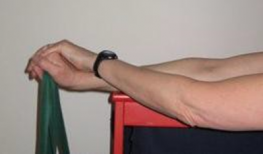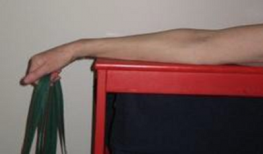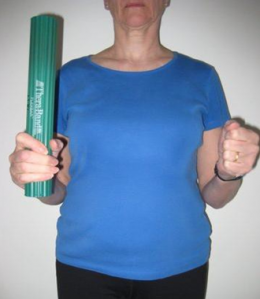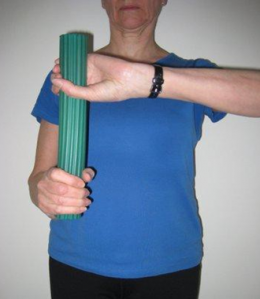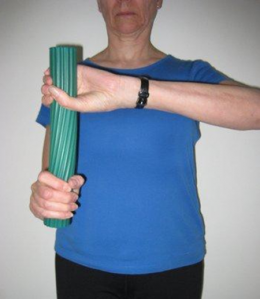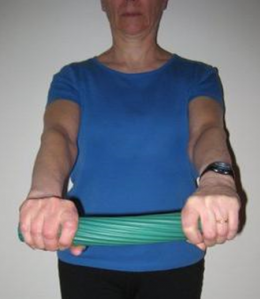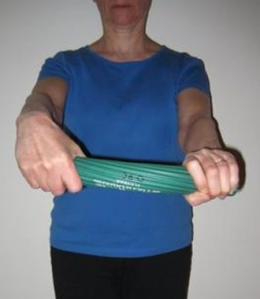Lateral Epicondyle Tendinopathy Toolkit: Section E - Exercise Prescription
Original Editor - Rishika Babburu for BC Physical Therapy Tendinopathy Task Force:
Dr. Joseph Anthony, Paul Blazey, Dr. Allison Ezzat, Dr. Angela Fearon, Diana Hughes, Carol Kennedy, Dr. Alex Scott, Michael Yates and Alison Hoens
Top Contributors - Evan Thomas, Rishika Babburu, Kim Jackson, Admin, Wanda van Niekerk and Vidya Acharya
This article is currently under review and may not be up to date. Please come back soon to see the finished work! (11/11/2022)
Introduction[edit | edit source]
Exercises for lateral epicondyle tendinopathy (LET) should be chosen according to patient preference, and the clinical evaluation.
There is a large volume of clinical evidence that consistently supports the use of exercise for management of chronic LET. Studies evaluating strength-based exercise have demonstrated improvement in symptoms regardless of the muscle contraction-type (e.g. concentric, eccentric or isometric). Some evidence suggests that eccentric exercises may provide superior pain relief, but providing an exercise that the patient can tolerate (isometric, concentric or eccentric) is the most important consideration.
The summary of interventions suggests (see section D) that clinicians strongly consider using local and upper limb kinetic chain exercises to support patients suffering from chronic LET. The following are examples of exercises to consider based upon the available literature
Concentric/Eccentric Home Exercise Program[1][edit | edit source]
Frequency:
Daily, for 3-months
Intensity:
- Resistance will be dictated by patient’s current capacity (e.g. 1 Repetition Maximum - RM)
Time:
- Aim is to complete 3 sets of 15 reps (approx. 65% of 1RM) once per day.
- Water can be used as resistance if you do not have weights available. 1 litre of water = approx’ 1kg.
- An option is to increase resistance by 0.1 kg (100ml water) weekly or as tolerated by the patient.
Supervised Eccentric Exercise and Stretching Program[edit | edit source]
Frequency: Once daily for 8-weeks
Intensity: Start at 20% Maximum Voluntary Contraction (MVC) progressively adding 5% every two weeks
Time:
30 seconds for 4 repetitions per day (30 secs rest between reps)
In the protocol the reps reduced to 3 but the contraction time increased to 45 seconds on alternating weeks. This was to generate a slow progression in the time-under-tension placed upon the lateral epicondyle tendon
| Figure 2A
Figure 2B |
The “Tyler Twist” Eccentric Wrist Extensor Exercise[edit | edit source]
[Needs a description of eccentric wrist externsor exercises]. The exercises below are based on a study (Tyler et al 2010[2])
|
Protocol:
| ||||||||
Resources[edit | edit source]
- Lateral Epicondyle Tendinopathy Toolkit page
- Section B - Clinical Assessment of LET
- Section C - Outcome Measures
- Section D - Summary of the Evidence
- Section F - Manual Therapy
- Section G - LASER Dosage Calculation
- Section H - Braces, Splints and Taping
- UBC Lateral Epicondyle Tendinopathy (LET) Toolkit
References[edit | edit source]
- ↑ Peterson M, Butler S, Eriksson M, Svardsudd K. A randomized controlled trial of exercise versus wait-list in chronic tennis elbow (lateral epicondylosis). Uppsala Journal of Medical Science. 2011; 116: 269-279.
- ↑ Tyler T, Thomas G, Nicholas S, McHugh M. Addition of isolated wrist extensor eccentric exercise to standard treatment for chronic lateral epicondylosis: a prospective randomized trial. Journal Of Shoulder And Elbow Surgery. Sep 2010; 19(6): 917-922.
